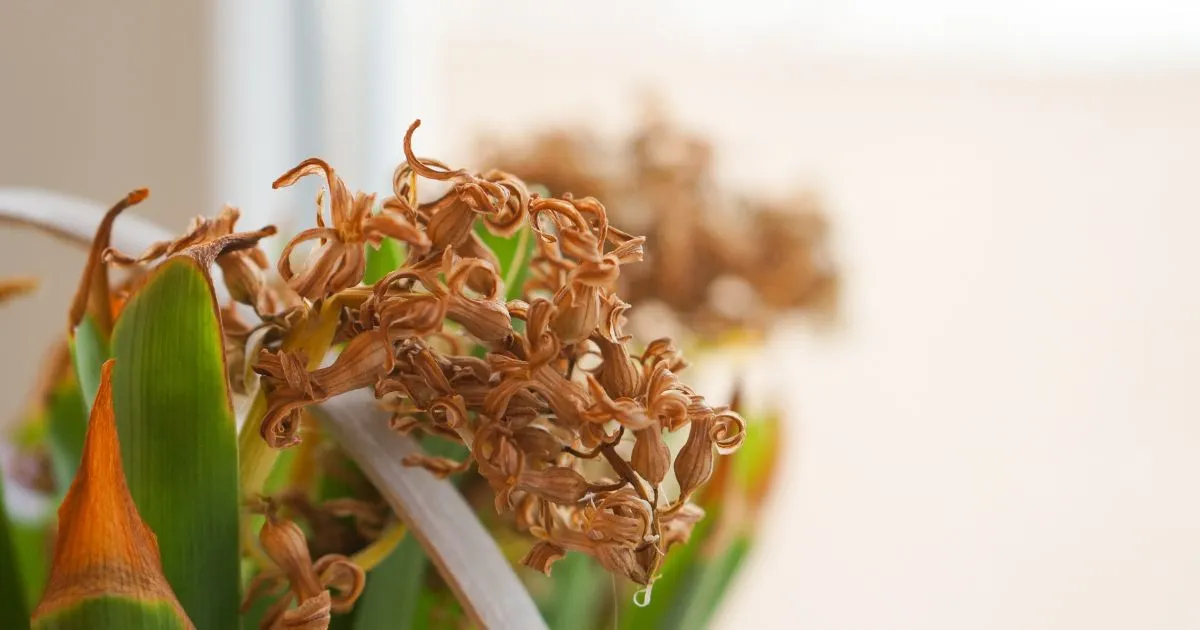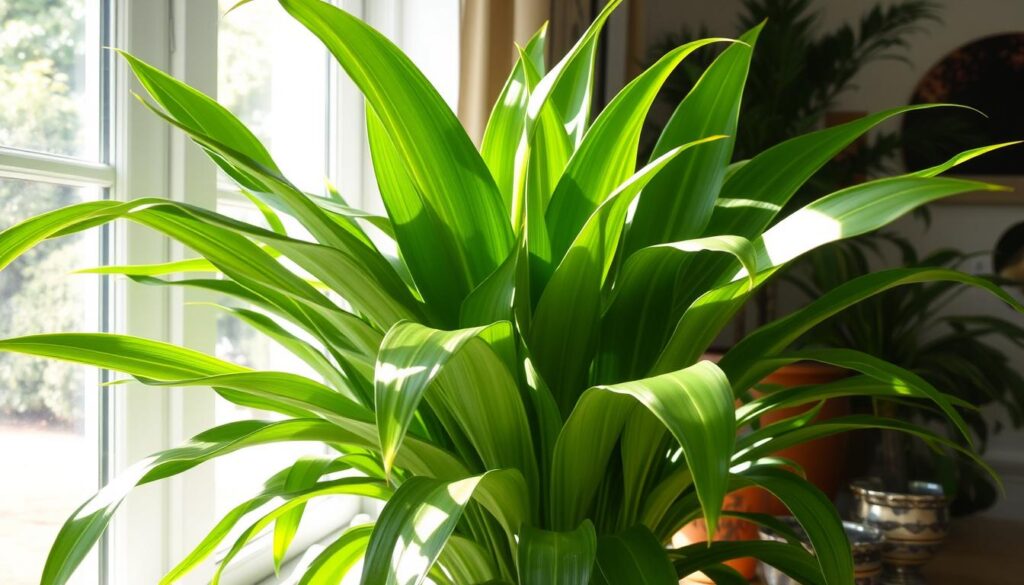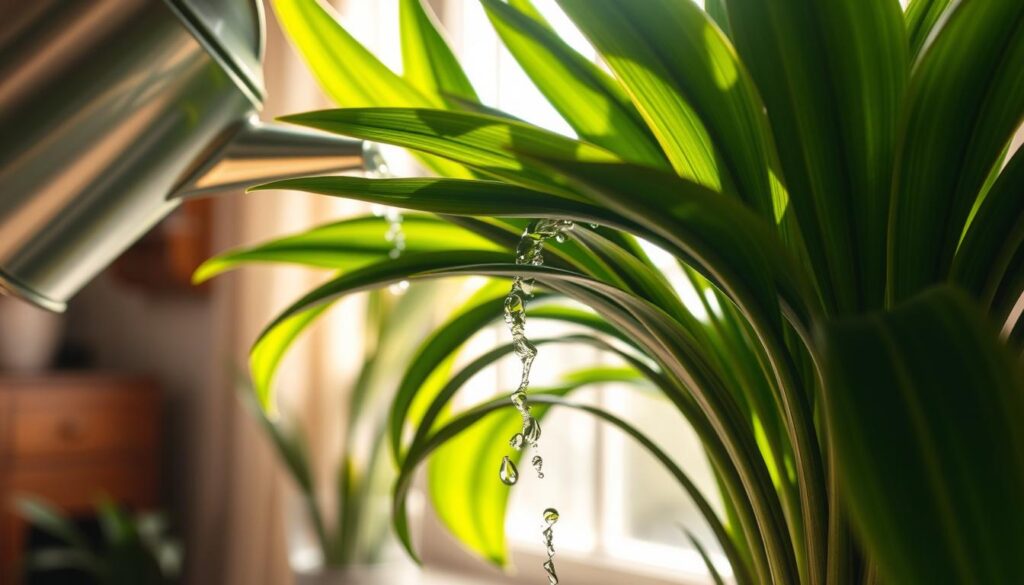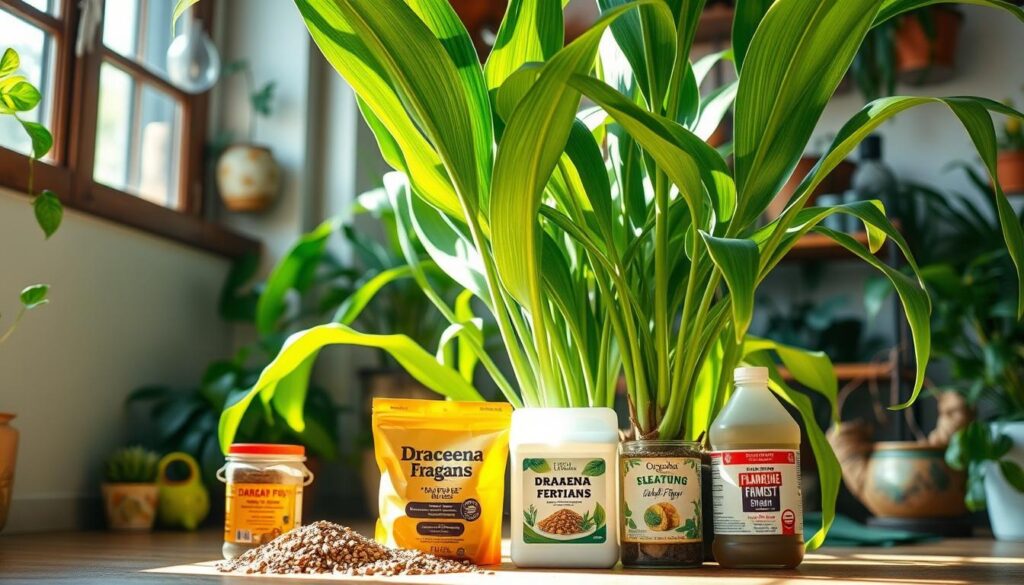Blog
Dracaena Fragrans Care: Growing Happy Corn Plants

Dracaena fragrans, also called the corn plant, is a favorite houseplant. It’s loved for its lush, tropical leaves and ability to clean the air. Its striking green leaves and upright growth make it a popular choice for homes and offices in the U.S.
Whether you’re new to plants or have experience, learning about Dracaena fragrans care is key. It helps you grow a vibrant corn plant that adds beauty to any room.

Table of Contents
Understanding the Dracaena Fragrans Plant
The dracaena fragrans, also known as the corn plant, is a popular houseplant. It comes from the tropical regions of Africa. This plant is known for its striking leaves and can grow well indoors.
Origin and Natural Habitat
The dracaena fragrans is from West Africa’s tropical forests. It can grow up to 15 feet tall. Its leaves are long and leathery.
Common Varieties and Characteristics
There are many varieties of the dracaena fragrans, like ‘Massangeana’ and ‘Lemon Lime’. These have different leaf colors, from green to yellow and lime. All have long, sword-shaped leaves.
Benefits as a Houseplant
The dracaena fragrans is great for indoor spaces. It purifies the air and is easy to care for. It can handle different lighting conditions, making it perfect for any room.
Light Requirements and Ideal Location
Dracaena fragrans, also known as the corn plant, loves bright, indirect light. It can handle lower light but grows best in sunny spots. Place it near a north- or east-facing window for the best light.
If you can’t find a bright window, don’t worry. Dracaena fragrans can handle moderate light, though it might grow slower. Avoid direct sunlight to prevent scorching and discoloration.
| Light Requirement | Optimal Location | Potential Issues |
|---|---|---|
| Bright, indirect light | Near a north- or east-facing window | Exposure to direct sunlight can scorch leaves |
| Moderate light | Any well-lit room without direct sunlight | Slower growth and potential leaf discoloration |
Give your dracaena fragrans the right light for healthy growth and color. Find a balance that meets its dracaena fragrans light requirements without too much or too little sunlight.
“Proper lighting is the foundation for a thriving dracaena fragrans plant. Get it right, and you’ll be rewarded with a lush, healthy corn plant.”
Dracaena Fragrans Care: Essential Growing Tips
Caring for your dracaena fragrans, also known as the corn plant, needs attention to certain factors. This ensures it grows well and stays healthy. Here are the key tips to help your corn plant flourish.
Temperature Requirements
Dracaena fragrans plants like a warm, cozy spot with temperatures between 60°F to 75°F (15°C to 24°C). Keep your corn plant away from sudden temperature changes or drafts. This can stress it and cause problems like leaf drop.
Humidity Needs
Dracaena fragrans loves humid air, aiming for 50-60% humidity. To boost humidity, use a pebble tray, place it near a humidifier, or group it with other plants. This creates a humid space around it.
Air Circulation Basics
Good air flow is key for your dracaena fragrans’ health. Stagnant air can lead to pests and diseases. Place your corn plant near an open window or use a small fan on low to ensure gentle air movement.
| Environmental Factor | Ideal Range |
|---|---|
| Temperature | 60-75°F (15-24°C) |
| Humidity | 50-60% |
| Air Circulation | Gentle, consistent movement |
By keeping the right temperature, humidity, and air flow, you’ll create a perfect environment. This will help your dracaena fragrans thrive and display vibrant, healthy leaves.
Proper Watering Techniques and Schedule
Keeping your Dracaena fragrans, or corn plant, healthy means getting the watering right. These tropical plants do best when their soil is slightly dry between waterings. Finding the right balance is key.
Water your dracaena when the top inch or two of soil feels dry. Don’t let the soil get too dry, as this can cause wilting. On the other hand, too much water can lead to root rot and fungal diseases.
The watering schedule depends on your plant’s size, the season, and your home’s environment. Water it once a week in spring and summer. In fall and winter, water every two to three weeks. Always check the soil before watering to see if it needs water.
| Season | Watering Frequency |
|---|---|
| Spring and Summer | Once a week |
| Fall and Winter | Every 2-3 weeks |
Use lukewarm, filtered water when you water your dracaena. Make sure the plant isn’t sitting in water. Letting the soil dry out a bit between waterings helps prevent yellow leaves, root rot, and mold.

“Proper watering is essential for the long-term health and vitality of your Dracaena fragrans. By following these guidelines, you can keep your corn plant thriving for years to come.”
Soil Requirements and Potting Mix Guide
Caring for your Dracaena fragrans, or “corn plant,” starts with the right soil. This tropical houseplant needs a mix that drains well and is rich in nutrients. It should feel like its natural home.
Best Soil Composition
The perfect soil for Dracaena fragrans is loose and airy. It should mix organic materials like peat moss, perlite, and slightly acidic compost or bark. This blend ensures good drainage and nutrients for your corn plant.
Drainage Considerations
Dracaena fragrans needs good drainage to avoid root rot. Make sure your pot has holes for water to drain. Adding gravel or pebbles at the bottom helps too. This keeps the roots healthy and happy.
pH Balance Requirements
Dracaena fragrans likes a slightly acidic soil pH, between 6.0 and 6.5. This pH helps it absorb nutrients well. If your soil’s pH is off, adjust it with the right materials to keep your plant healthy.
| Soil Characteristic | Ideal Range |
|---|---|
| pH | 6.0 – 6.5 |
| Drainage | Well-draining |
| Organic Matter | Peat moss, compost, bark |
| Aeration | Perlite, sand |
Give your Dracaena fragrans the right dracaena fragrans soil mix, drainage, and pH balance. You’ll have a thriving, healthy corn plant. It will add lush, tropical beauty to your home.
Fertilizing Your Corn Plant
Proper fertilization is key for your dracaena fragrans, also known as the corn plant. Knowing the right fertilizer and when to use it helps your dracaena fragrans stay healthy and beautiful indoors.
Choosing the Right Fertilizer
For your dracaena fragrans, choose a balanced, water-soluble houseplant fertilizer. A fertilizer with an NPK ratio of 20-20-20 or 10-10-10 is best. It gives your plant the nutrients it needs to grow well.
Fertilizing Frequency
In the growing seasons of spring and summer, feed your dracaena fragrans every 4-6 weeks. This keeps it healthy and green. But, during the quiet winter months, cut back to fertilizing every 2-3 months.
Avoiding Over-Fertilization
Be careful not to over-fertilize your dracaena fragrans. Too much fertilizer can harm your plant. Always follow the fertilizer package’s instructions and don’t use more than recommended.
By fertilizing your dracaena fragrans correctly, you help it stay vibrant and healthy. This ensures your corn plant thrives indoors.

Pruning and Maintenance Guidelines
Keeping your Dracaena fragrans, or corn plant, healthy and looking good needs regular care. The right pruning keeps your plant bushy and stops it from getting too long. It also makes your plant look its best.
When to Prune
The best time to prune your Dracaena fragrans is in the spring or early summer. This is when it’s growing the most. Don’t prune in winter, as it’s dormant and can get stressed.
Proper Cutting Techniques
Use sharp pruning shears or scissors to cut your Dracaena fragrans. Make clean cuts to avoid damage. Cut just above a leaf node, angling the cut slightly down for better healing.
Maintenance Schedule
Prune your Dracaena fragrans every 6-12 months, depending on how fast it grows. Also, clean the leaves with a damp cloth often. This helps the plant photosynthesize better.
| Pruning Frequency | Leaf Cleaning |
|---|---|
| Every 6-12 months | Regularly wipe down leaves |
“Proper pruning and maintenance are essential for keeping your Dracaena fragrans thriving and looking its best.”
By following thesedracaena fragrans pruningguidelines, your corn plant will stay healthy and look great for years.
Troubleshooting Common Problems
Caring for your Dracaena fragrans, or corn plant, can be rewarding. But, you might face some common issues. Brown leaf tips often happen due to wrong watering, low humidity, or too much sunlight. To fix this, water consistently and mist the leaves to keep humidity right.
Yellow leaves can mean too much water, not enough nutrients, or pests. If your leaves turn yellow, check the soil moisture and adjust your watering. Also, give your plant a balanced fertilizer and look for pests.
Pests like spider mites, mealybugs, or scale insects can harm your Dracaena fragrans. They can make leaves discolored, slow growth, and even harm the plant. Check your plant often. If you find pests, treat them quickly with the right insecticides or natural solutions to keep your plant healthy.
FAQ
What are the light requirements for a Dracaena fragrans (corn plant)?
Dracaena fragrans likes bright, indirect light. It can handle lower light too. Place it where it gets plenty of filtered sunlight but avoid direct sunlight to prevent leaf scorch.
How often should I water my Dracaena fragrans?
Water your Dracaena fragrans when the top inch or two of soil feels dry. Don’t let the soil dry out completely to avoid wilting. But, don’t overwater to prevent root rot. The right watering schedule depends on the plant’s size, the season, and your home’s environment.
What type of soil is best for a Dracaena fragrans?
Dracaena fragrans does well in a well-draining, slightly acidic potting mix. Choose a soil made for houseplants or succulents. It should drain well and have the right nutrients. Avoid heavy soils that can cause waterlogging and root rot.
How do I prune my Dracaena fragrans?
Pruning helps keep your Dracaena fragrans bushy and healthy. Use sharp pruning shears to remove dead or damaged leaves. You can also trim the plant to control its height. Make clean, angled cuts to protect the plant.
What are the common problems I might encounter with my Dracaena fragrans?
Common problems include brown leaf tips, yellow leaves, and droopy leaves. These can be due to too much or too little water, not enough light, or pests. Fix these issues by adjusting your care and watching your plant closely.